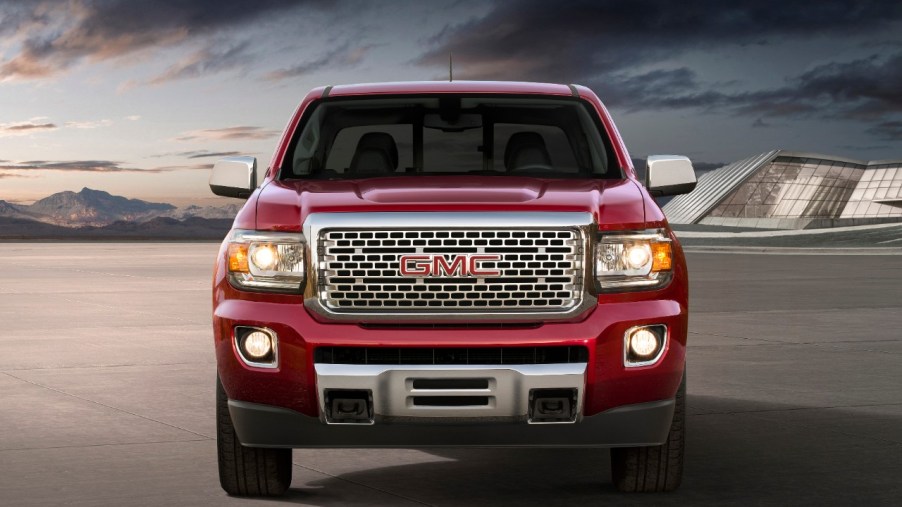
Is the Four-Cylinder GMC Canyon Any Good?
Over the past few years, reviewers have generally had good things to say about the GMC Canyon. But the positive feedback we’ve read so far has been for the Canyons that have either a V6 or a diesel engine. So, how does the four-cylinder Canyon rate? We’ll find out from the folks at Car and Driver whether the version with the smaller engine is any good.
Better fuel economy?
With the four-cylinder Canyon‘s EPA rating of 20 mpg city and 27 highway, GM boasted the best fuel economy in the mid-size truck segment when this review was written in 2015. These numbers weren’t that much better than those of rivals Nissan Frontier, Toyota Tacoma, and Honda Ridgeline. At 19 mpg city and 25 mpg highway, the 4X4 version was worse yet. In 2019, the Canyon/Colorado twins and the Ridgeline offer about the same fuel economy, according to Edmunds.com.
To make matters worse, the Canyon’s fuel economy ratings were only 1- or 2 mpg better than the V6 versions, as Alexander Stoklosa of Car and Driver pointed out. And it was only a smidge more than the base V6 Chevy Silverado and GMC Sierra 4X4 pickups that rate 17 mpg city and 22 mpg highway.
The Car and Driver 2015 test truck was a 4X4 extended cab that got a middling 18 mpg. A V6 Canyon crew cab got 17 mpg and was quicker, too. The four-cylinder Canyon lumbered along at 9.2 seconds in a zero to 60 mph run, while the V6 version clocked a respectable 7.5 seconds. The Chevy Silverado 4X4 crew cab also performed better at 7.7 seconds. Stoklosa felt that sacrificing a small amount of fuel economy would be worth it to benefit from the better acceleration of the Canyon’s and Silverado’s V6 engines.
The limitations of this engine
A 2.5-liter inline-four just isn’t enough power for a Canyon, according to Stoklosa. He and other reviewers at the magazine have consistently recommended the 3.6-liter V6 engine version over the four-cylinder one. And there are enough compelling reasons for the recommendation.
The four-cylinder Canyon delivers 200 hp and 191 lb-ft of torque. At first glance, these specs don’t seem too terrible, especially when a 2-5-liter four-cylinder Nissan Frontier makes 152 hp and 171 lb-ft of torque. A 2.7-liter four-cylinder Toyota Tacoma produces 159 hp and 180 lb-ft.
But those specs don’t tell the whole story. For a mid-size truck, the Canyon is heavy with a curb weight of 4,158 pounds. The cheaper, simpler engine is grossly underpowered for a truck with this much heft. Towing capacity suffers too, with the four-cylinder maxing out at just 3,500 pounds. By comparison, the V6 Canyon has a tow rating of 7,000 pounds and the Sierra/Silverado twins max out at 7,600 pounds.
The six-speed automatic transmission mated with the four-cylinder Canyon didn’t serve it well, either. Stoklosa said that it tended to jump into higher gear ratios unnecessarily, as on a slight incline at highway speed, for example. He needed to downshift maintain speed, and the engine lacked the response he hoped for. Also, the horsepower peak at 6,300 rpm and the torque peak at 4,400 rpm are geared too close to redline for drivers to get the best use from them.
Why make a four-cylinder Canyon at all?
It’s puzzling why GM bothers to offer this version. The rationale for giving buyers better fuel economy is rather weak. And the automaker’s reasoning that some buyers might want the base model four-cylinder SL as a work truck is also unconvincing. Given its low power and torque, this version would probably struggle to carry out its duties on the worksite.
The 306-hp 3.6-liter V6 with an eight-speed automatic transmission is an option for every trim level except the base model SL. Depending on the trim level buyers choose, they would pay from $1,885 for the second from lowest trim to the $950 for the top trim level for the V6. This additional cost seems like a relatively small price to pay to get enough power to not only double the Canyon’s towing capacity but also to match the truck’s weight.
The GMC Canyon handles well for a mid-size truck. And compared to its corporate twin, the Chevy Colorado, it has better styling and a nicer interior despite its lack of some active safety features. It’s considerably cheaper than a Silverado or a Sierra. But we agree with Car and Driver’s evaluation of this $30,200 four-cylinder truck: if buyers want a GMC Canyon, they should skip the four-cylinder and buy the V6.


